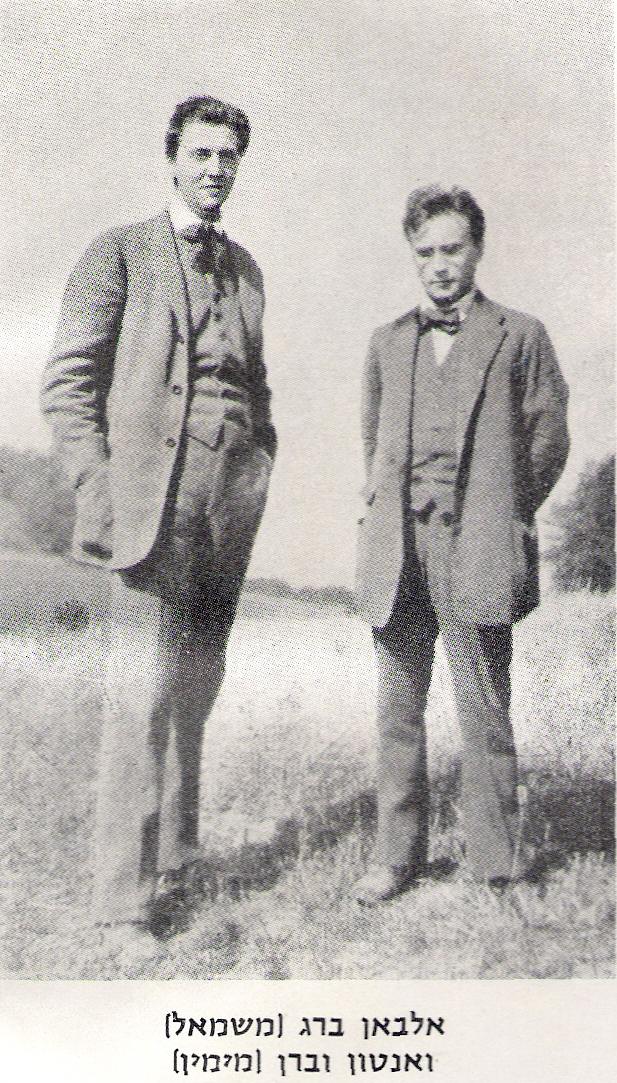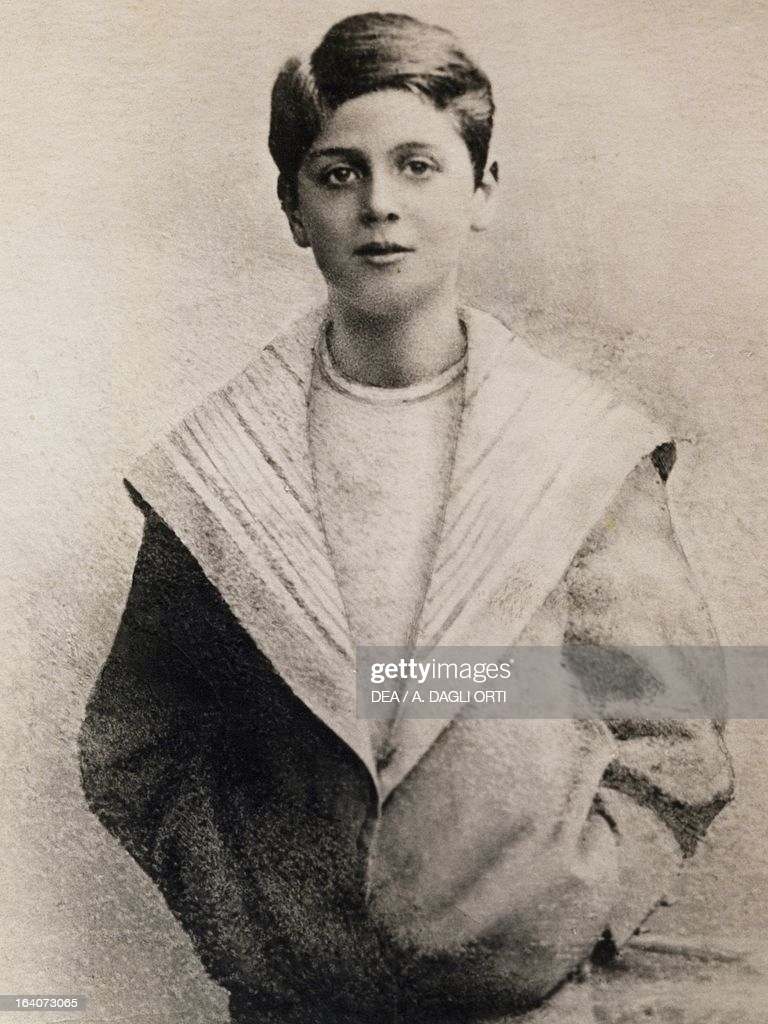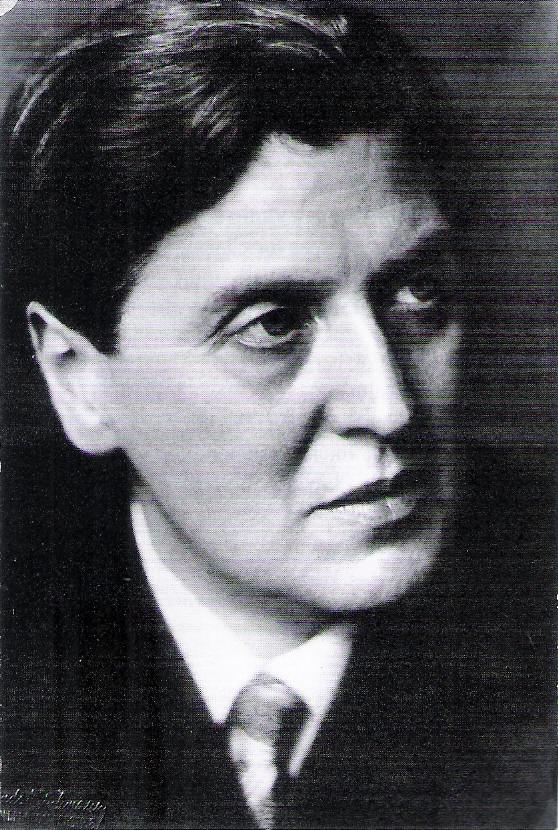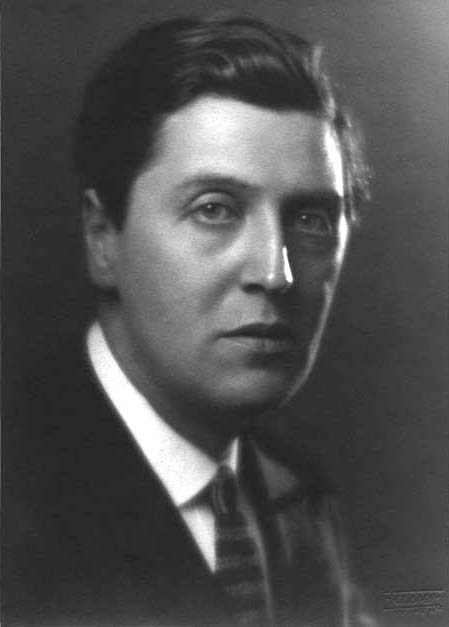
Foto boven: Webern en Berg



9 February 1885 – 24 December 1935) was an Austrian composer of the Second Viennese School. His compositional style combined Romantic lyricism with the twelve-tone technique. Although he left a relatively small oeuvre, he is remembered as one of the most important composers of the 20th century for his expressive style encompassing “entire worlds of emotion and structure”.
Berg was born and lived in Vienna. He began to compose only at the age of fifteen. He studied counterpoint, music theory and harmony with Arnold Schoenberg between 1904 and 1911, and adopted his principles of developing variation and the twelve-tone technique. Berg’s major works include the operas Wozzeck (1924) and Lulu (1935, finished posthumously), the chamber pieces Lyric Suite and Chamber Concerto, as well as a Violin Concerto. He also composed a number of songs (lieder). He is said to have brought more “human values” to the twelve-tone system, his works seen as more “emotional” than Schoenberg’s. His music had a surface glamour that won him admirers when Schoenberg himself had few.
Berg died from sepsis in 1935.
Early life
Berg was born in Vienna, the third of four children of Johanna and Konrad Berg. His father ran a successful export business, and the family owned several estates in Vienna and the countryside. The family’s financial situation turned to the worse after the death of Konrad Berg in 1900, and it particularly affected young Berg, who had to repeat both his sixth and seventh grade to pass the exams. Berg was more interested in literature than music as a child and did not begin to compose until he was fifteen, when he started to teach himself music. With Marie Scheuchl, a maid in the family estate of Berghof in Carinthia and fifteen years his senior, he fathered a daughter, Albine, born 4 December 1902.
Berg had little formal music education before he became a student of Arnold Schoenberg in October 1904. With Schoenberg, he studied counterpoint, music theory, and harmony. By 1906 he was studying music full-time; by 1907 he began composition lessons. His student compositions included five drafts for piano sonatas. He also wrote songs, including his Seven Early Songs (Sieben Frühe Lieder), three of which were Berg’s first publicly performed work in a concert that featured the music of Schoenberg’s pupils in Vienna that year.
The early sonata sketches eventually culminated in Berg’s Piano Sonata, Op. 1 (1907–1908); it is one of the most formidable “first” works ever written. Berg studied with Schoenberg for six years until 1911. Among Schoenberg’s teaching was the idea that the unity of a musical composition depends upon all its aspects being derived from a single basic idea; this idea was later known as developing variation. Berg passed this on to his students, one of whom, Theodor W. Adorno, stated: “The main principle he conveyed was that of variation: everything was supposed to develop out of something else and yet be intrinsically different” The Piano Sonata is an example—the whole composition is derived from the work’s opening quartal gesture and its opening phrase.
Innovation
Berg was a part of Vienna’s cultural elite during the heady fin de siècle period. His circle included the musicians Alexander von Zemlinsky and Franz Schreker, the painter Gustav Klimt, the writer and satirist Karl Kraus, the architect Adolf Loos, and the poet Peter Altenberg.
In 1906 Berg met the singer Helene Nahowski (de) (1885–1976), daughter of a wealthy family (said by some to be in fact the illegitimate daughter of Emperor Franz Joseph I of Austria from his liaison with Anna Nahowski). Despite the outward hostility of her family, the two were married on 3 May 1911.Watschenkonzert, caricature in Die Zeit, 6 April 1913
In 1913 two of Berg’s Altenberg Lieder (1912) were premièred in Vienna, conducted by Schoenberg in the infamous Skandalkonzert. Settings of aphoristic poetic utterances, the songs are accompanied by a very large orchestra. The performance caused a riot, and had to be halted. He effectively withdrew the work, and it was not performed in full until 1952. The full score remained unpublished until 1966.
From 1915 to 1918 Berg served in the Austro-Hungarian Army. During a period of leave in 1917 he accelerated work on his first opera, Wozzeck. After the end of World War I, he settled again in Vienna, where he taught private pupils. He also helped Schoenberg run his Society for Private Musical Performances, which sought to create the ideal environment for the exploration and appreciation of unfamiliar new music by means of open rehearsals, repeat performances, and the exclusion of professional critics.
Berg had a particular interest in the number 23, using it to structure several works. Various suggestions have been made as to the reason for this interest: that he took it from the biorhythms theory of Wilhelm Fliess, in which a 23-day cycle is considered significant, or because he first suffered an asthma attack on the 23rd of the month.
Success of Wozzeck and inception of Lulu (1924–29)
In 1924 three excerpts from Wozzeck were performed, which brought Berg his first public success. The opera, which Berg completed in 1922, was first performed on 14 December 1925, when Erich Kleiber conducted the first performance in Berlin. Today, Wozzeck is seen as one of the century’s most important works. Berg made a start on his second opera, the three-act Lulu, in 1928 but interrupted the work in 1929 for the concert aria Der Wein which he completed that summer. Der Wein presaged Lulu in a number of ways, including vocal style, orchestration, design and text.
Other well-known Berg compositions include the Lyric Suite (1926), which was later shown to employ elaborate cyphers to document a secret love affair; the post-Mahlerian Three Pieces for Orchestra (completed in 1915 but not performed until after Wozzeck); and the Chamber Concerto (Kammerkonzert, 1923–25) for violin, piano, and 13 wind instruments: this latter is written so conscientiously that Pierre Boulez has called it “Berg’s strictest composition” and it, too, is permeated by cyphers and posthumously disclosed hidden programs.
Final years (1930–35)
Life for the musical world was becoming increasingly difficult in the 1930s both in Vienna and Germany due to the rising tide of antisemitism and the Nazi cultural ideology that denounced modernity. Even to have an association with someone who was Jewish could lead to denunciation, and Berg’s “crime” was to have studied with the Jewish composer Arnold Schoenberg. Berg found that opportunities for his work to be performed in Germany were becoming rare, and eventually his music was proscribed and placed on the list of degenerate music
In 1932 Berg and his wife acquired an isolated lodge, the Waldhaus on the southern shore of the Wörthersee, near Schiefling am See in Carinthia, where he was able to work in seclusion, mainly on Lulu and the Violin Concerto. At the end of 1934, Berg became involved in the political intrigues around finding a replacement for Clemens Krauss as director of the Vienna State Opera.
As more of the performances of his work in Germany were cancelled by the Nazis, who had come to power in early 1933, he needed to ensure the new director would be an advocate for modernist music. Originally, the premiere of Lulu had been planned for the Berlin State Opera, where Erich Kleiber continued to champion his music and had conducted the premiere of Wozzeck in 1925, but now this was looking increasingly uncertain, and Lulu was rejected by the Berlin authorities in the spring of 1934. Kleiber’s production of the Lulu symphonic suite on 30 November 1934 in Berlin was also the occasion of his resignation in protest at the extent of conflation of culture with politics. Even in Vienna, the opportunities for the Vienna School of musicians was dwindling
Berg had interrupted the orchestration of Lulu because of an unexpected (and financially much-needed) commission from the Russian-American violinist Louis Krasner for a Violin Concerto (1935). This profoundly elegiac work, composed at unaccustomed speed and posthumously premiered, has become Berg’s best-known and most-beloved composition.[citation needed] Like much of his mature work, it employs an idiosyncratic adaptation of Schoenberg’s “dodecaphonic” or twelve-tone technique, that enables the composer to produce passages openly evoking tonality, including quotations from historical tonal music, such as a Bach chorale and a Carinthian folk song. The Violin Concerto was dedicated “to the memory of an Angel”, Manon Gropius, the deceased daughter of architect Walter Gropius and Alma Mahler
Death
Berg died aged 50 in Vienna, on Christmas Eve 1935, from blood poisoning apparently caused by a furuncle on his back, induced by an insect sting that occurred in November. He was buried at the Hietzing Cemetery in Vienna.
Before he died, Berg had completed the orchestration of only the first two of the three acts of Lulu. The completed acts were successfully premièred in Zürich in 1937. For personal reasons Helene Berg subsequently imposed a ban on any attempt to “complete” the final act, which Berg had in fact completed in short score. An orchestration was therefore commissioned in secret from Friedrich Cerha and premièred in Paris (under Pierre Boulez) only in 1979, soon after Helene Berg’s own death. The complete opera has rapidly entered the repertoire as one of the landmarks of contemporary music and, like Wozzeck, remains a consistent audience draw.
Legacy
Berg is remembered as one of the most important composers of the 20th century and the most widely performed opera composer among the Second Viennese School. He is said to have brought more “human values” to the twelve-tone system, his works seen as more “emotional” than Schoenberg’s. Critically, he is seen as having preserved the Viennese tradition in his music.
Berg scholar Douglas Jarman writes in the New Grove Dictionary of Music and Musicians that “[as] the 20th century closed, the ‘backward-looking’ Berg suddenly came as [George] Perle remarked, to look like its most forward-looking composer.”[
Alban Berg Quartett was a string quartet named after him, active during 1971–2008.
The asteroid 4528 Berg is named after him (1983). https://en.wikipedia.org/wiki/Alban_Berg
Alban Berg (1885-1935): Violin concerto “To the Memory of an Angel” (1935), dedicated to Manon Gropius, the daughter to Walter, the well known architect and founder of the Bauhaus, and Alma Gropius, Gustav Mahler’s widow. Concerto pour violon “A la Mémoire d’un Ange” dédicacé à Manon Gropius, la fille de l’architecte et fondateur du Bauhaus de Dessau, Walter Gropius, et de la veuve du compositeur et chef d’orchestre viennois Gustav Mahler, Alma Gropius. I Andante – Allegretto (00:00–10:57); II Allegro – Adagio (10:58-26:00) Perlman; Ozawa: Boston Symphony Orchestra
Alban Berg (1885-1935): Violin concerto “To the Memory of an Angel” (1935), dedicated to Manon Gropius, the daughter to Walter, the well known architect and founder of the Bauhaus, and Alma Gropius, Gustav Mahler’s widow. Concerto pour violon “A la Mémoire d’un Ange” dédicacé à Manon Gropius, la fille de l’architecte et fondateur du Bauhaus de Dessau, Walter Gropius, et de la veuve du compositeur et chef d’orchestre viennois Gustav Mahler, Alma Gropius. I Andante – Allegretto (00:00–10:57); II Allegro – Adagio (10:58-26:00) Perlman; Ozawa: Boston Symphony Orchestra
Alban Berg (1885-1935) – Violin Concerto “To the Memory of an Angel” (1935) 1. Andante (Prelude) – Allegretto (Scherzo) (00:30) 2. Allegro (Cadenza) – Adagio (Chorale Variations) (11:17) Ivry Gitlis, violin Hans Vonk, conductor WDR Symphony Orchestra Cologne To the Memory of an Angel! Rest in Peace, Ivry Gitlis (25 August 1922 – 24 December 2020)!
De Nationale Opera presenteert voor het eerst de complete versie van Alban Berg’s opera Lulu, geregisseerd door multikunstenaar William Kentridge. Meer info: http://bit.ly/youLulu
‘Niets minder dan een mirakel’, schreef Het Parool over sopraan Barbara Hannigan. Enige jaren geleden breidde de Canadese haar loopbaan als sopraan uit. Ze debuteerde als dirigent, met een gigantisch succes. Haar programma met LUDWIG, waarin ze haar beide rollen combineerde, won De Ovatie 2014, voor beste concert van het jaar.
After his production of Médée (DVD & Blu-ray Bel Air Classiques), Krzysztof Warlikowski once again delves the innermost depths of the human psyche and tackles Alban Berg’s opera Lulu as a deeply moving requiem ‘to the memory of an angel’, and Canadian soprano Barbara Hannigan gives a tremendous, never-to-be-forgotten account of the title role. Available on DVD ! Check out on Amazon : http://geni.us/k8IX Learn more on website : http://geni.us/vxzyfJ Subscribe to BelAir Classiques : http://bit.ly/2g1aCPA Follow on Facebook : http://bit.ly/BelAirFacebook Follow on Twitter : http://bit.ly/TwitterBelAir Follow on Instagram : http://bit.ly/InstaBelAir The nuptials of eros and thanatos unveil their irresistible attraction in this second opera of Alban Berg who, following Wozzeck, describes the sometimes bright and often bestial intensity of human relations. Intoxicatingly enigmatic and deadly for those close to her, Lulu’s secret goes with her unto death. From the folly of love to the humiliation of vulgarity, she incites the excess. She unhinges reality… Frank Wedekind’s work provided fertile ground for the composer to create this striking opera, considered one of the major works of the 20th century, but which remained unfinished due to his untimely death in 1935. Opera in three acts by Alban Berg After Frank Wedekind’s tragedies Erdgeist and Die Büchse der Pandora Third act by Friedrich Cerha Lulu : Barbara Hannigan Gräfin Geschwitz : Natascha Petrinsky Dr. Schön & Jack The Ripper : Dietrich Henschel Orchestre symphonique de la Monnaie Conductor : Paul Daniel Stage Direction : Krzysztof Warlikowski Directed for TV by Myriam Hoyer
Music and libretto by Alban Berg, after the play by Georg Büchner Wozzeck: Toni Blankenheim Marie: Sena Jurinac Drum Major: Richard Cassilly Andres: Peter Haage Captain: Gerhard Unger Doctor: Hans Sotin Workman I: Kurt Moll Workman II: Franz Grundheber Idiot: Kurt Marschner Margret: Elisabeth Steiner Marie’s son: Martina Schumacher The Hamburg Philharmonic State Orchestra The Chorus of the Hamburg State Opera Conducted by Bruno Maderna Directed for television by Joachim Hess Set design: Herbert Kirchhoff Costumes: Helmut Jürgens Recorded 1970, Hamburg State Opera
Dietrich Fischer-Dieskau discusses opera roles. Jon Tolansky presents a series of 6 video podcasts featuring interview material he recorded with the great baritone. In each podcast Tolansky introduces one opera featuring Dietrich Fischer-Dieskau, who discusses the work and his role in it. The third episode highlights Fischer-Dieskau’s portrayal of Wozzeck in the acclaimed recording of Alban Berg’s Wozzeck conducted by Karl Böhm, recorded in Berlin in 1965. The interview with Dietrich Fischer-Dieskau took place in Berlin in 2000. Dietrich Fischer-Dieskau discusses opera roles #3/6 | Alban Berg: „Wozzeck“ Listen to ‘Wozzeck’: https://lnk.to/0SwqV Subscribe here – The Best Of Classical Music: http://bit.ly/Subscribe_DG
Wozzeck, Op. 7, composed by Alban Berg (1925). Performed by the Orchester des Deutschen Opernhauses Berlin, conducted by Karl Böhm, with Gerhard Stolze, Helmut Melchert, Kurt Bohme, Robert Koffmane, Evelyn Lear, Karl Christian Kohn, Alice Oelke, Fritz Wunderlich, Martin Vantin, and Dietrich Fischer-Dieskau. This recording of “Wozzeck” received four international awards: the US Grammy for Best Opera Recording (1965), France’s Grand Prix du Disque (1965), Holland’s Edison Award (1966) and France’s Grand Prix des Discophiles (1966). Sellner and Gerdes were nominated in 1966 for the Grammy for “Best Opera Notes” for this recording. Wozzeck…………………….Dietrich Fischer-Dieskau Tambourmajor……………..Helmut Melchert Andres………………………Fritz Wunderlich Hauptmann…………………Gerhard Stolze Doktor………………………..Karl Christian Kohn 1. Handwerksbursch…..Kurt Böhme 2. Handwerksbursch…..Robert Koffmane Der Narr……………………..Martin Vantin Marie………………………….Evelyn Lear Margret……………………….Alice Oelke Soldat…………………………Walter Muggelberg (Note: Last year I uploaded this work in 8 segments, but am pleased to be able now to share it in its entirety, without interruption.) The Library of Congress catalog entry for this work can be viewed here: http://lccn.loc.gov/r65003531 About this recording: Distributed in 1965 by Deutsche Grammophon (LP serial numbers are “138 991” and “138 992”; the container ID is “2707 023”). Performance produced by German conductor and record producer Otto Gerdes (1920-1989). Recording supervision, Wolfgang Lohse; recording engineer, Günter Hermanns. Recorded at UFA Studios, Berlin, March 24, 1965 through April 4, 1965. Notes on the opera by Gustav Rudolf Sellner (general manager and chief director, from 1961 to 1972, of the Deutsche Oper in West Berlin); on the recording, Otto Gerdes; and on the structure of the work, in German, English and French, and German libretto, with English translation by Eric Blackall and Vida Harford and French translation by Pierre Jean Jouve (35 pages, the green booklet you will see in the video). Images in this video are taken from the LP box cover, the LP label, and the libretto included in the boxed set. The last four images are Karl Böhm rehearsing with the Orchester des Deutschen Opernhauses Berlin; Karl Böhm, Evelyn Lear, and Dietrich Fischer-Dieskau reviewing the libretto and score; Gustav Rudolf Sellner meeting Evelyn Lear and Fischer-Dieskau; and Karl Böhm speaking with Gustav Rudolf Sellner. Also from Berg: Juilliard String Quartet, 1950: Lyric Suite for String Quartet – Complete – http://www.youtube.com/watch?v=GU_HIv… “David Hertzberg”
Alban Berg Lyric Suite for string quartet (1925-1926) Allegretto gioviale 00:00 Andante amoroso 03:09 Allegro misterioso – Trio estatico 09:26 Adagio appassionato 12:43 Presto delirando – Tenebroso 19:05 Largo desolato 24:00 Juilliard String Quartet Robert Mann, violin Earl Carlyss, violin Samuel Rhodes, viola Claus Adam, cello Live recording: Ascona, August 24, 1970 Painting: Amedeo Modigliani, The Red Woman, 1915, Turin, Galleria d’Arte Moderna The Lyric Suite is a six-movement work for string quartet written by Alban Berg between 1925 and 1926 using methods derived from Schoenberg’s twelve-tone technique. […] As Berg’s friend and fellow Schoenberg pupil Erwin Stein wrote in the preface to the score, “The work (Ist and VIth part, the main part of the IIIrd and the middle section of the Vth) has been mostly written strictly in accordance with Schoenberg’s technique of the ‘Composition with 12 inwardly related tones.’ A set of 12 different tones gives the rough material of the composition, and the portions which have been treated more freely still adhere more or less to the technique” […] Theodor W. Adorno called the quartet “a latent opera”. Eztract from https://en.wikipedia.org/wiki/Lyric_S…
